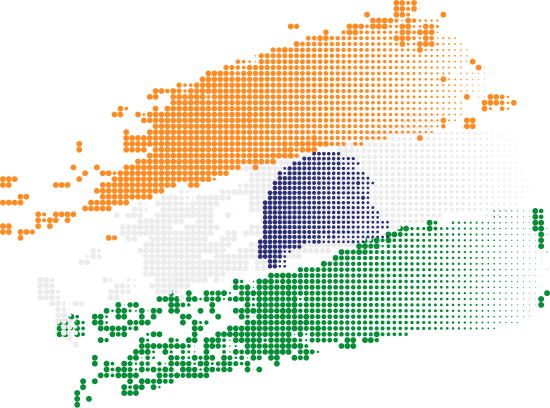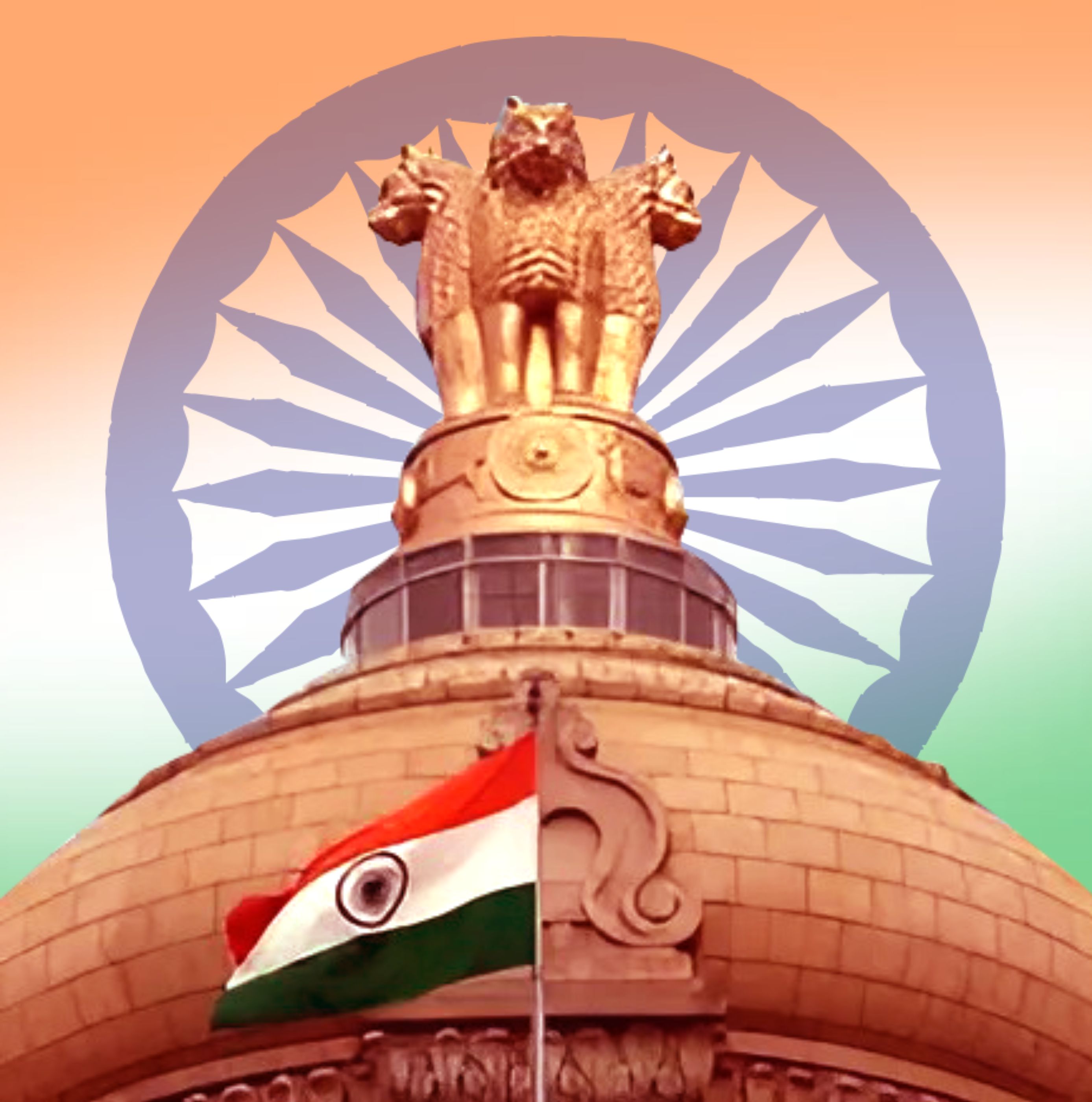

Constitution Of India
Introduction
The Constitution of India (also known as the Indian Constitution or Bharat's Rajyaghatan) is the supreme law of India. This document lays out the fundamental political code, structure, procedures, powers, and duties of government institutions, as well as the fundamental rights, directive principles, and duties of citizens. It is the largest written national constitution in the world. Dr. B. R. Ambedkar is the principal architect of the Indian Constitution.
The Constitution establishes constitutional supremacy (not parliamentary supremacy, since it was created by a Constituent Assembly rather than Parliament) and was adopted by the people through its Preamble. Parliament cannot override the Constitution.
It was adopted by the Constituent Assembly of India on 26 November 1949 and came into effect on 26 January 1950. The Constitution replaced the Government of India Act 1935 as the country’s fundamental governing document, and the Dominion of India became the Republic of India. To ensure constitutional autonomy, the framers repealed previous British parliamentary acts through Article 395. India celebrates 26 January as Republic Day to honor the enforcement of its Constitution.
The Constitution declares India as a sovereign, socialist, secular, and democratic republic and guarantees justice, equality, liberty, and fraternity to its citizens. The original 1950 Constitution is preserved in a helium-filled case in the Parliament House, New Delhi. The words “secular” and “socialist” were added to the Preamble during the 42nd Amendment in 1976 during the Emergency period.


History
The Indian Constitution, enforced in 1950, is largely based on the Government of India Act of 1935, which laid the foundation for internal self-governance in India. British Prime Minister Clement Attlee’s idea of forming a drafting committee for an independent Indian constitution was welcomed by leaders of India’s independence movement. In the summer of 1946, this committee was established, and its first meeting was held on 9 December 1946 in New Delhi under the chairmanship of Dr. Sachchidananda Sinha and vice-chairmanship of Frank Anthony. On 11 December, Dr. Rajendra Prasad was elected as the President, and Asutosh Mukherjee as the Vice President of the Assembly. This hall is now known as the Central Hall of the Parliament. The first meeting was attended by 211 members, including 9 women.
After India attained independence on 15 August 1947, the committee briefly functioned as India’s representative body. On 29 August 1947, the Drafting Committee was formed under the leadership of Dr. B. R. Ambedkar. It was the most important committee, tasked with drafting the Constitution. After several meetings, the final draft was submitted and adopted on 26 November 1949. Therefore, 26 November is observed as Constitution Day in India. Provisions related to citizenship, elections, and the interim parliament were implemented immediately, while the Constitution in its entirety came into effect on 26 January 1950, which is celebrated as Republic Day.
Parts of the Constitution
The Constitution of India has a total of 22 Parts and 12 Schedules.
| Part | Articles | Subject |
|---|---|---|
| Part I | Articles 1 to 4 | Union and its Territory |
| Part II | Articles 5 to 11 | Citizenship |
| Part III | Articles 12 to 35 | Fundamental Rights |
| Part IV | Articles 36 to 51 | Directive Principles of State Policy |
| Part IVA | Article 51A | Fundamental Duties |
| Part V | Articles 52 to 151 | Union Government |
| Part VI | Articles 152 to 237 | State Governments |
| Part VII | 9th Amendment (Repealed) | (Repealed) |
| Part VIII | Articles 238 to 242 | Union Territories |
| Part IX | Articles 243 to 243O | Panchayati Raj |
| Part IXA | Articles 243P to 243ZG | Municipalities |
| Part IXB | Articles ZH to ZT | Co-operative Societies |
| Part X | Articles 244 to 244A | Scheduled and Tribal Areas |
| Part XI | Articles 245 to 263 | Centre-State Relations |
| Part XII | Articles 264 to 300A | Finance, Property, Contracts and Suits |
| Part XIII | Articles 301 to 307 | Trade, Commerce and Intercourse within the Territory of India |
| Part XIV | Articles 308 to 323 | Services under the Union and States, Public Service Commissions |
| Part XIV A | Articles 323A, 323B | Tribunals |
| Part XV | Articles 324 to 329A | Elections and Election Commission |
| Part XVI | Articles 330 to 342 | Special Provisions for SCs, STs, OBCs and Anglo-Indians |
| Part XVII | Articles 343 to 351 | Official Language |
| Part XVIII | Articles 352 to 360 | Emergency Provisions |
| Part XIX | Articles 361 to 367 | Miscellaneous |
| Part XX | Article 368 | Amendment of the Constitution |
| Part XXI | Articles 369 to 392 | Temporary, Transitional and Special Provisions |
| Part XXII | Articles 393 to 395 | Short Title, Commencement and Repeals |
Schedules of the Constitution
| Sr. No. | Schedule | Subject |
|---|---|---|
| 1. | Schedule I | States and Union Territories. |
| 2. | Schedule II | Salaries and allowances (President, Governor, Speaker and Deputy Speaker of Lok Sabha, Chairman and Deputy Chairman of Rajya Sabha, Speaker and Deputy Speaker of State Legislative Assemblies, Chairman and Deputy Chairman of State Legislative Councils, Judges of the Supreme Court, Judges of High Courts, Comptroller and Auditor General of India) |
| 3. | Schedule III | Oath and Affirmation (Union Ministers, elected candidates to Parliament, Members of Parliament, Judges of the Supreme Court, Comptroller and Auditor General of India, State Ministers, elected candidates to State Legislature, State Legislators, Judges of High Courts) |
| 4. | Schedule IV | Allocation of seats in the Rajya Sabha to States and Union Territories |
| 5. | Schedule V | Provisions related to administration and control of Scheduled Areas and Scheduled Tribes |
| 6. | Schedule VI | Provisions for administration of tribal areas in Assam, Meghalaya, Tripura, and Mizoram |
| 7. | Schedule VII | Union, State, and Concurrent Lists – (1) Union List – 97 subjects (2) State List – 66 subjects (3) Concurrent List – 52 subjects (earlier 47) |
| 8. | Schedule VIII | Languages (Number of languages listed in the Constitution: currently 22 languages) |
| 9. | Schedule IX | Implementation of certain laws – This schedule was added through the First Constitutional Amendment Act, 1951. |
| 10. | Schedule X | Provision for disqualification of members on the ground of defection. Included by the 52nd Constitutional Amendment Act of 1985. |
| 11. | Schedule XI | Powers and responsibilities of Panchayati Raj institutions. Contains 29 subjects. Included by the 73rd Amendment Act, 1992. |
| 12. | Schedule XII | Powers and responsibilities of Municipalities. Contains 18 subjects. Included by the 74th Amendment Act, 1992. |
Chronology
- 6 December 1946: Establishment of the Constituent Assembly (as per French practice)
- 9 December 1946: First meeting of the Constituent Assembly took place in the Central Hall of the current Parliament House. J. B. Kripalani was the first to address the Assembly. Dr. Sachchidananda Sinha became the temporary president. (The Muslim League boycotted the Assembly, demanding a separate state.)
- 11 December 1946: The Assembly elected Dr. Rajendra Prasad as the President of the Constituent Assembly, Dr. Harendra Kumar Mukherjee as Vice-President, and B. N. Rau as the Constitutional Legal Advisor. (Initially, there were 389 members, which dropped to 299 after partition. Of the 389, 292 were from provinces, 4 from chief commissioner provinces, and 93 from princely states.)
- 13 December 1946: Jawaharlal Nehru presented an "Objective Resolution" that outlined the basic principles. This later became the Preamble to the Constitution.
- 22 January 1947: The Objective Resolution was unanimously adopted.
- 22 July 1947: The new national flag was adopted.
- 15 August 1947: India gained independence. India and Pakistan became separate dominions.
- 29 August 1947: Dr. B. R. Ambedkar was appointed Chairman of the Drafting Committee. Other members included: K. M. Munshi, Mohammad Saadulla, Alladi Krishnaswami Ayyar, N. Gopalaswami Ayyangar, T. T. Krishnamachari (replacing D. P. Khaitan, who died in 1948). B. L. Mitter replaced N. Madhava Rao, who resigned due to ill health.
- 16 July 1948: Like Harendra Kumar Mukherjee, V. T. Krishnamachari was elected as the second Vice-President of the Assembly.
- 26 November 1949: The Indian Constitution was adopted and passed by the Constituent Assembly.
- 24 January 1950: Final meeting of the Constituent Assembly. The Constitution, with 395 articles, 8 schedules, and 22 parts, was signed and approved.
- 26 January 1950: The Constitution came into effect. (This process took 2 years, 11 months, and 18 days and cost a total of ₹6.4 million.)